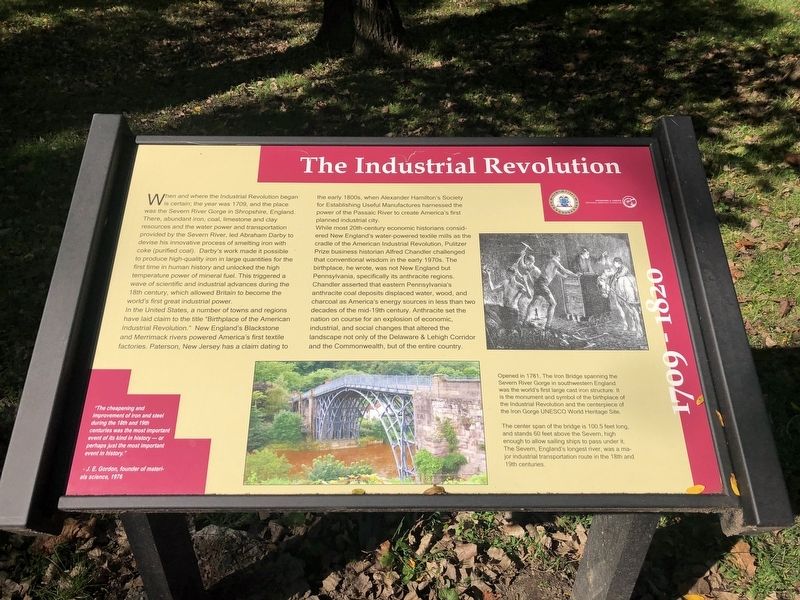Easton in Northampton County, Pennsylvania — The American Northeast (Mid-Atlantic)
The Industrial Revolution
1709 - 1820
When and where the Industrial Revolution began is certain; the year was 1709, and the place was the Severn River Gorge in Shropshire, England. There, abundant iron, coal, limestone and clay resources and the water and transportation provided by the Severn River, led by Abraham Darby to devise his innovative process of smelting iron with coke (purified coke). Darby's work made it possible to produce high-quality iron in large quantities for the first time in human history and unlocked the high temperature power of mineral fuel. This triggered a wave of scientific and industrial advances during the 18th century, which allowed Britain to become the world's first great industrial power.
In the United States, a number of towns and regions have laid claim to the title "Birthplace of the American Revolution." New England's Blackstone and Merrimack rivers powered America's first textile factories. Paterson, New jersey has a claim dating to the early 1800s, when Alexander Hamilton's Society for Establishing Useful Manufactures harnessed the power of the Passaic River to create America's first planned industrial city.
While most 20th-century economic historians considered New England's water-powered textile mills as the cradle of the American Industrial Revolution, Pulitzer Prize business historian Alfred Chandler challenged that conventional wisdom in the early 1970s. The birthplace, he wrote, was not New England but Pennsylvania, specifically its anthracite regions. Chandler asserted that eastern Pennsylvania's anthracite coal deposits displaced water, wood, and charcoal as America's energy sources in less than two decades of the mid-19th century. Anthracite set the nation on course for an explosion of economic, industrial, and social changes that altered the landscape not only of the Delaware & Lehigh Corridor and the Commonwealth, but of the entire country.
"The cheapening and improvement of iron and steel during the 18th and 19th centuries was the most important event of its kind in history — or perhaps just the most important event in history."
— J.E. Gordon, founder of materials science, 1976
[Captions:]
Opened in 1781, the Iron Bridge spanning the SEvern River Gorge in southwestern England was the world's first large cast iron structure. It is the monument and symbol of the birthplace of the Industrial Revolution and the centerpiece of the Iron Gorge UNESCO World Heritage Site.
The center span of the bridge is 100.5 feet long and stands 60 feet above the Severn, high enough to allow sailing ships to pass under it. The Severn, England's longest river, was a major industrial transportation
Erected by City of Easton, Pennsylvania.
Topics. This historical marker is listed in these topic lists: Bridges & Viaducts • Industry & Commerce. A significant historical year for this entry is 1709.
Location. 40° 40.147′ N, 75° 14.186′ W. Marker is in Easton, Pennsylvania, in Northampton County. Marker is on Hugh Moore Park Road, 0.1 miles south of Hill Road, on the left when traveling south. Touch for map. Marker is in this post office area: Easton PA 18042, United States of America. Touch for directions.
Other nearby markers. At least 8 other markers are within walking distance of this marker. Hugh Moore Park (a few steps from this marker); From Brownfields to Greenfields (within shouting distance of this marker); Men of Iron (within shouting distance of this marker); Birthplace of the American Industrial Revolution (within shouting distance of this marker); Iron in Colonial Pennsylvania (within shouting distance of this marker); Fathers of the Industrial Revolution (about 300 feet away, measured in a direct line); The Promise of Anthracite Coal (about 500 feet away); Lehigh Crane Iron Company (about 500 feet away). Touch for a list and map of all markers in Easton.
Credits. This page was last revised on October 5, 2020. It was originally submitted on October 5, 2020, by Devry Becker Jones of Washington, District of Columbia. This page has been viewed 122 times since then and 15 times this year. Photos: 1, 2. submitted on October 5, 2020, by Devry Becker Jones of Washington, District of Columbia.

